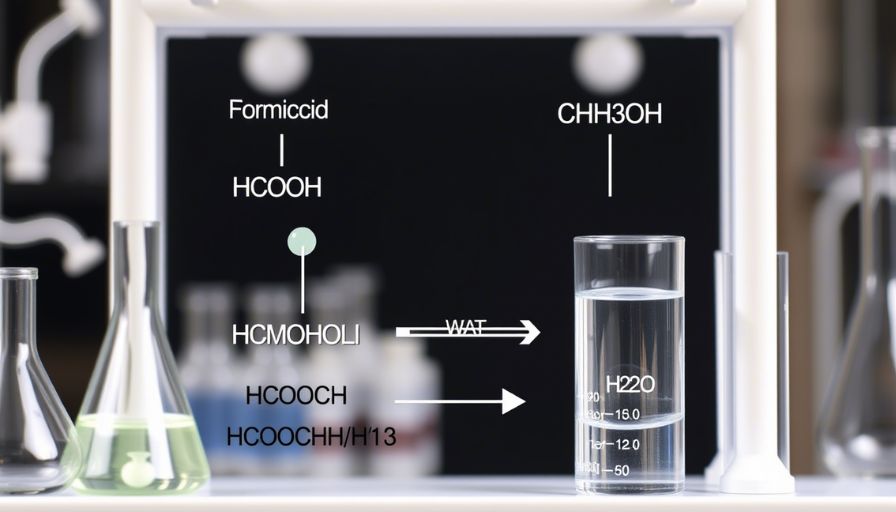The chemical expression HCOOCH CH2 H2O does not represent a single compound but rather hints at the coexistence or interaction of formic acid, formaldehyde (CH₂), and water (H₂O). These three components appear in several important chemical reactions and industrial applications, making their combination highly relevant in both organic and inorganic chemistry.
In this article, we will decode the significance of each component, explore their chemical behavior, and examine real-world reactions and uses involving HCOOCH CH2 H2O.
Breaking Down the Components
Formic Acid (HCOOH)
-
IUPAC Name: Methanoic acid
-
Formula: HCOOH
-
Structure: H–C(=O)–OH
Formic acid is the simplest carboxylic acid and serves as a reducing agent, a hydrogen source, and a preservative in agriculture and food industries. In the shorthand “HCOOCH,” the HCOO refers to the formate ion derived from formic acid.
Key Uses:
-
Leather and textile processing
-
Preservative in animal feed (E236)
-
Laboratory reagent for transfer hydrogenation
-
Intermediate in chemical manufacturing
Safety Note: Corrosive and causes skin and respiratory irritation.
Methylene / Formaldehyde (CH₂)
-
Formula: CH₂O (Formaldehyde)
-
Structure: H–C(=O)–H
The “CH₂” segment often refers to formaldehyde, a highly reactive aldehyde used in resins, adhesives, and organic syntheses. In water, formaldehyde exists in equilibrium with its hydrate (CH₂(OH)₂), forming a dynamic reaction system.
Key Uses:
-
Resin and polymer production
-
Intermediate in Eschweiler–Clarke and Cannizzaro reactions
-
Disinfectant and biological preservative
Safety Note: Known carcinogen, toxic and irritating to eyes and skin.
Water (H₂O)
Water acts as both a solvent and reactant in systems involving formic acid and formaldehyde. It participates in hydration, proton transfer, and sometimes influences the formation of hydrates or azeotropes.
Key Roles:
-
Solvent for chemical reactions
-
Reagent in hydration or hydrolysis
-
Stabilizes intermediates through hydrogen bonding
Common Reactions Involving HCOOCH CH2 H2O
1. Eschweiler–Clarke Reaction
Formic acid and formaldehyde are used to methylate amines:
Reaction:
RNH₂ + HCHO + HCOOH → R–NHCH₃ + CO₂ + H₂O
-
CH₂ acts as a methylating agent
-
HCOOH donates hydride to reduce intermediates
-
Water acts as a reaction medium
This is a classic method to form tertiary amines.
2. Cannizzaro Reaction
In basic conditions, formaldehyde undergoes disproportionation:
Reaction:
2 HCHO + OH⁻ → HCOO⁻ + CH₃OH
-
One molecule is oxidized to formate (HCOO⁻)
-
The other is reduced to methanol
-
Water is both reactant and product
This pathway effectively turns CH₂ into HCOOH via redox chemistry.
3. Hydration and Dehydration
Formaldehyde in water forms methanediol (CH₂(OH)₂):
Reaction:
CH₂O + H₂O ⇌ CH₂(OH)₂
Similarly, formic acid can dehydrate:
Reaction:
HCOOH → CO + H₂O (with acids or heat)
These reversible reactions show water’s role in shifting equilibrium.
4. Condensation to Glycolic Acid
Under acid catalysis, formic acid and formaldehyde combine:
Reaction:
HCOOH + HCHO → HOCH₂COOH (glycolic acid)
This results in a C–C bond formation, merging CH₂ and HCOOH into a hydroxy acid.
5. Hydrogen Generation
Formic acid decomposes into hydrogen gas:
Reaction:
HCOOH → H₂ + CO₂ (over catalyst like Pt)
-
Used in fuel cells (DFAFCs)
-
Water acts as solvent or is produced
Mixtures involving formic acid and CH₂ are studied for hydrogen storage and green energy applications.
Real-World Applications
Organic Synthesis
-
Used to produce methylated amines and hydroxy acids
-
Common in university labs and industrial reactions
Fuel and Energy
-
Direct formic acid fuel cells use HCOOH as liquid fuel
-
Studied as hydrogen source for clean energy technologies
Resins and Materials
-
Formaldehyde-based resins (e.g., urea-formaldehyde)
-
Formic acid in textile and leather treatments
Agriculture and Food
-
HCOOH as a preservative (E236)
-
Formaldehyde (though banned in food) once used in feed preservation
Catalysis and Redox Systems
-
Mixtures of formic acid, formaldehyde, and water explored in hydrogenation catalysts
-
Useful in hydrothermal reactions and transition metal reductions
Practical Laboratory Examples
-
Glycolic Acid Formation: Mixing formic acid and formaldehyde under acidic conditions yields hydroxy acids
-
Amines Methylation: Student experiments use HCOOH + CH₂O + amines to produce tertiary amines
-
Fuel Cell Demos: Small DFAFC setups demonstrate green electricity from formic acid and water
-
Preservation: Solutions of formalin (CH₂O in H₂O) and formic acid used to preserve biological samples
Safety Considerations
Formic Acid
-
Corrosive, causes burns and fumes
-
Must use gloves, goggles, and proper ventilation
Formaldehyde
-
Toxic and a Group 1 carcinogen
-
Fume hoods and low exposure are essential
Water
-
Safe on its own but critical in dilution and buffering during handling of HCOOH and CH₂O
Conclusion
Though not a standard formula, HCOOCH CH2 H2O symbolically represents a powerful trio in chemistry:
-
Formic Acid (HCOOH): Acid and hydrogen donor
-
Formaldehyde (CH₂): Reactive aldehyde or methylene unit
-
Water (H₂O): Universal solvent and reaction medium
Together, they participate in methylation, condensation, redox, and hydrogen-generating reactions across labs and industries. Understanding this group provides insight into both classical organic reactions and modern applications in green chemistry and energy systems.
